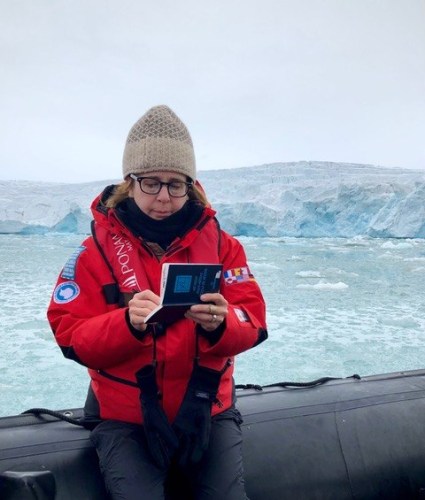
Based on her travels to the Svalbard Archipelago (Norway), Pia De Girolamo’s arctic landscape paintings portray moody, barren terrains, vast expanses of water and often a lone polar bear, acting as both witness and guide. Her diffuse light, spare palette, and simplification of forms pay homage to American Modernists such as Milton Avery, Arthur Dove, and Marsden Hartley. She translates the massive physicality of the landscape with a profound sense of mystery and isolation that belies the small boundaries of her canvases. Pia De Girolamo received a BA in Art History from Barnard College, Columbia University as well as an MD degree from the University of Rochester. She has had 14 solo shows, including her recent at the Museo Mastroianni in Lauro, Rome, and many group exhibitions. She lives in the greater Philadelphia area and lectures on the nexus between Art and Medicine.
Artist Essay on Arctic Series:
78°N 16°E: The Arctic Series
One week in the Svalbard Archipelago above the Arctic Circle in May of 2019 was all it took for this unforgettable environment to insinuate itself into my paintings. Since that trip, the Arctic landscape and fauna became the subject of a series of paintings. I have been to many rugged isolated locales but visiting the Arctic was like visiting another planet. Not only were there vast expanses of water and masses of ice in varied configurations but the light was unique. It lasted all day, for one. The sun never set but merely dipped to just above the horizon where it shown weakly before it rose up again. I never felt like sleeping. Changing light could transform a landscape from a blazing bright vision to a brooding, moody vista.
The local inhabitants were equally interesting. Polar bears, seals, walruses, pods of beluga whales, arctic terns and more revealed themselves. I felt like an interloper. As much as I was grateful to be taking this trip part of me felt that perhaps I shouldn’t have come. This place of pristine beauty had already been touched by humans, often quite savagely, for centuries; whale species decimated by the hundreds of thousands, failed mining operations, polar explorations by dogsled, plane and dirigible, and most recently, research stations and who knows what other secret installations, their satellite dishes and huts set down upon mountain tops . Climate change already affected the area and produced that first rains ever seen.
brought a small sketch book and took lots of photos. When I got back to my studio, and reviewed them, the images flowed onto the canvas and panels and they kept on coming.
Coincidentally, the images of isolated landscapes resonated powerfully with the social distancing we were all doing while in lockdown during the COVID 19 pandemic. Layered upon the formalistic qualities of the painting as a reflection of the landscape and the powerful impressions arising from that immediate experience, was the experience of uncertainty, fear and disconnection produced by the pandemic.
The Anthropocene is fully upon us and we and successive generations will bear its consequences but perhaps we can still make things better for future generations by stopping the headlong rush to destroy the earth. I hope that these paintings are a reminder to others there is beauty and life and treasure at the top of the world that is worth saving. If we save it, we save ourselves. That this series ended up being shaped by my response to the realities of the pandemic also makes it one record of art created during an unprecedented planet-wide catastrophe.






